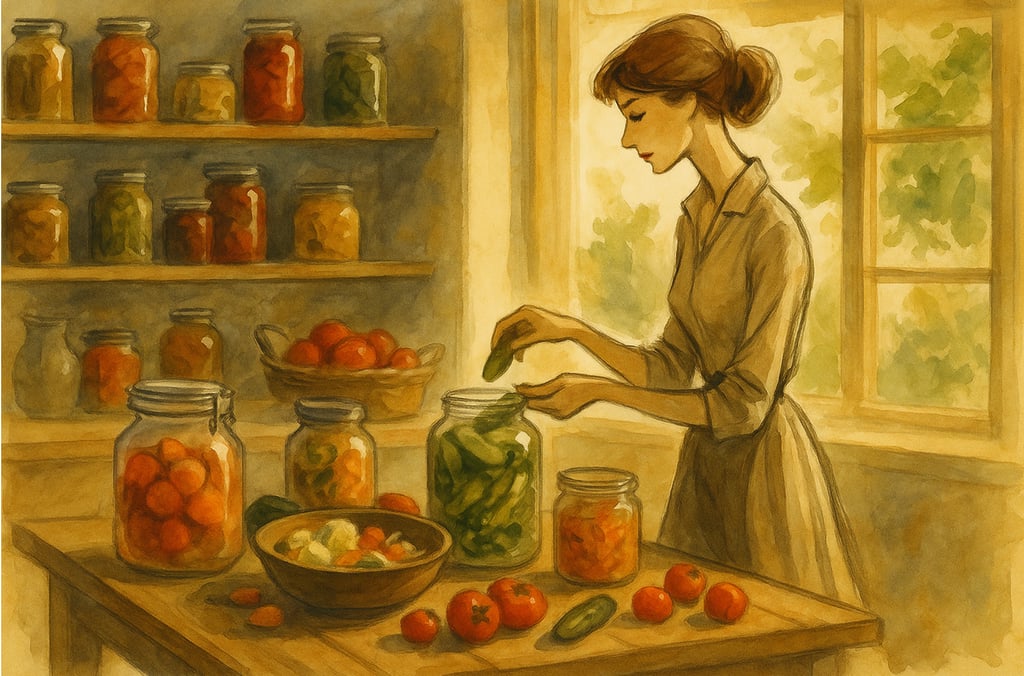The Twelve Days of Fermentation: Preserving Summer’s Bounty for a Winter’s Table
Preserve the end of summer with ancient fermentation traditions. Learn how cultures around the world pickle, brine, and ferment — and why August is the best time to begin.
FOOD HISTORY & TRADITIONSFERMENTATION


It’s August. The air is thick with heat, the garden overflows, and deep in kitchens around the world, something begins to bubble. Not the fizz of fashionably bottled kombucha or Instagram-worthy sourdough starters, but something older, quieter — more elemental.
This is fermentation season. And for many cultures, it’s as essential as the harvest itself.
A Tradition Rooted in Survival
Before fridges and supermarkets, fermentation wasn’t a hobby — it was how families made it through the winter. These “twelve days” are not a formal calendar, but a rough cycle: the brief window at summer’s end when vegetables are ripe, time is short, and the weather still cooperates. This is when hands get busy slicing, salting, and sealing, preserving the flavour and nutrition of summer just in time for the frost.
In Romanian villages, this is when gogonele — unripe green tomatoes — are preserved with garlic, horseradish, and dill. In Korea, communities prepare for kimjang, the ritual fermentation of kimchi that nourishes entire families through the long winter. In Sweden, the first salted cucumbers of the season begin to fizz in dark ceramic crocks in the cool cellar.
Though methods vary, the spirit is shared: fermentation is care, memory, and magic all at once.
How Fermentation Works — and Why It’s Special
Fermentation is a collaboration with microbes. You don’t cook the food — you invite it to change. In the presence of salt and the absence of air, natural bacteria begin to digest sugars in vegetables or fruits, releasing lactic acid, alcohol, or carbonation. This transformation preserves the food, enhances its flavour, and boosts its nutritional value.
💡 Did you know? Lacto-fermented vegetables like sauerkraut are full of gut-friendly probiotics, and vitamin C levels actually increase during fermentation.
The most powerful part? You can’t rush it. It’s a process of faith and patience. You prepare the ingredients, cover the jar, and wait — letting time and nature do the work.
Family Rituals, Folk Knowledge, and Fermenting by Feel
In some homes, there are no exact recipes. Just intuition. A scoop of salt “about the size of your grandmother’s palm.” A slice of sour apple or rye bread to start the culture. A sprig of dill, a bay leaf, a whispered blessing.
Some families swear by starting on a specific day each year. Others wait for a sign — a shift in the light, a chill in the wind, or the garden’s final cucumber.
What unites them is memory. The process is passed down like a lullaby. These jars are more than food — they’re ancestral knowledge in glass.
A Living Pantry for Cold Days Ahead
Fermented foods don’t just preserve summer — they evolve with time. A cucumber pickled in August might be sharp and crisp in September, then mellow and complex by December. Each jar is alive, changing, becoming. Just like us.
When the frost finally arrives, and fresh produce disappears from the markets, these jars come down from the shelf. And with each bite, you taste:
Sunlight in a salted plum
August wind in a cabbage leaf
A summer memory, still fizzing
Fermentation Around the World
Fun Fact Round-Up
Korea’s kimjang tradition is so culturally significant it’s listed by UNESCO as Intangible Cultural Heritage.
In Eastern Europe, some families begin pickling on a set date each August, tied to local saints’ days or lunar calendars.
In rural Turkey, pickling parties bring neighbours together — often with music, food, and jars lined up like sentinels of the season.
In Japan, miso and nukazuke are made in home fermentation beds with regional grains and precise timing.
Ready to Try Your Own?
Whether you’re preserving garden cucumbers or exploring fermented plum compote, the key is to embrace the rhythm. Fermentation isn’t fast — and that’s the point.
Starter Tips:
Always use non-iodised salt (like sea salt).
Keep your jars clean, but don’t over-sterilise — the right bacteria need a home.
Use breathable cloths or lids that allow air to escape.
Store in a cool, dark place.
Check daily — and taste bravely!
In the End, It’s About More Than Food
Fermentation teaches patience, trust, and transformation. In a world that rushes everything, it asks you to slow down. To let things become what they’re meant to be.
And when winter comes — really comes — and your table is lean but your pantry is glowing, you’ll know:
You bottled sunlight.
You made time edible.
You waited. And something beautiful happened.
